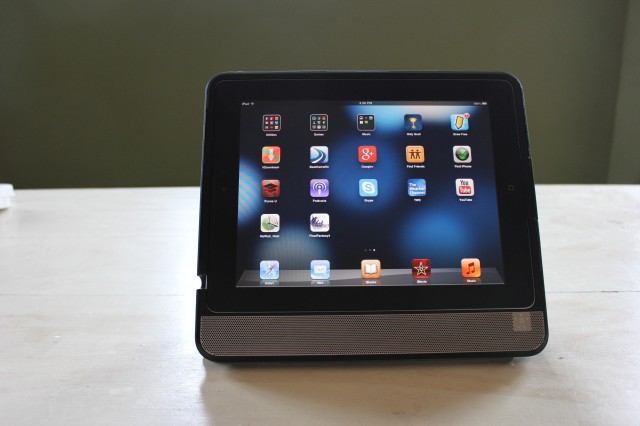
At this year's CES in Las Vegas, Belkin showed off its latest product: an iPad case. In a world wheregigabit wireless is on the horizon, this doesn't seem like the most daring or logical move for the well-respected networking company. But in a briefing a few weeks before the announcement, representatives from the company told me that Belkin is branching out and trying to create a “connected atmosphere” and a “connected experience” around mobile devices. Plus, this iPad case is different—it comes with an integrated 2.1 sound system made by Belkin and its partner Audifi.
The Thunderstorm Handheld Theater, which currently only accommodates the iPad 2 and the third generation iPad, isn't exactly cheap: at $200, it costs about half of what you'd pay for an entry-level iPad 2. But I've found the Thunderstorm to be a very good mobile audio system—as long as you want to broadcast to the whole room.
Extra baggage or gravitas?
The Thunderstorm adds much more heft to the normally svelte iPad: it turns your 9.5” × 7.3” × 0.34” tablet into a chunky 10.1” × 9” × 0.8”. It also adds an extra 1.4 pounds onto the roughly 1.3 pounds of a second and third generation iPad. All this extra bulk comes in the form of strong matte black plastic. A 1.2” × 9.9” silver speaker grating resides on the left side of the iPad (if you're holding it vertically). There's also a 0.4” × 1.5” matte black grille on the bottom side of the case through which the iPad's own integrated speaker can be heard if you don't have the Thunderstorm attached properly or you've turned if off for some reason.
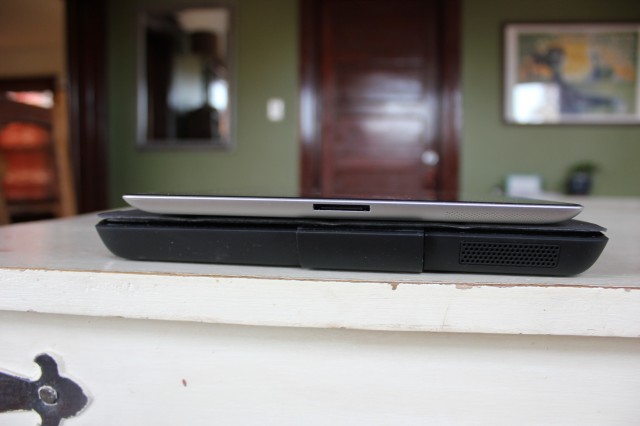
The tablet hooks into the case by way of a latch to the 30-pin connector. Originally, Belkin designed the latch with a button that releases it from the iPad. That original design was a little stiff and made getting the tablet in and out of the case difficult, but Belkin says it has refined the design since, chucking the button and making it so the latch just slides in and out. We didn't have a chance to use this updated latch, so we can't say for sure whether it's a true fix to the hardware problem.
The upside to all this extra weight is that, combined with the tight grip that the latch has on the iPad, this case feels as sturdy as it feels heavy. Once you get your tablet in there, you'll have a hard time finding an accident that can get it out.
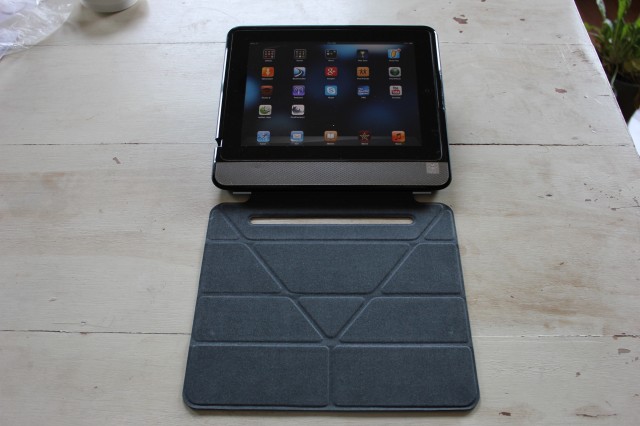
The case also conforms to the functional structure of the iPad, with an opening in the back so that it doesn't obstruct the camera (you crazy people taking pictures with an iPad, calm down), a proxy button at the top to power on and off, an opening for the headphone jack, and another to plug the case into an outlet. On the right side of the iPad, you have a tiny switch to mute the speaker sound and a volume rocker.
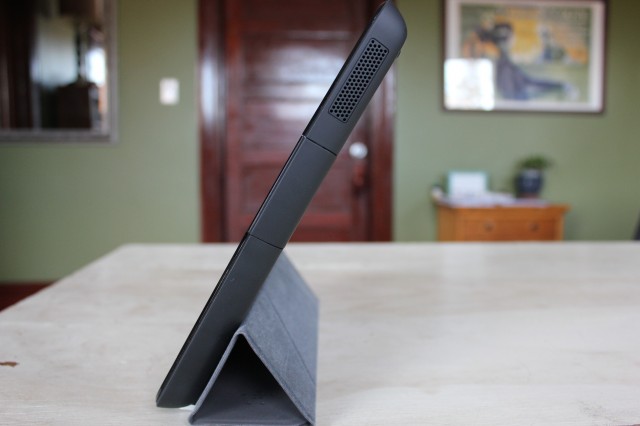
The cover of the case is another matter. The gray, multifold, integrated cover on the case feels as flimsy as the case proper feels sturdy. I found myself fiddling with the cover many times, trying to get it to fold just right so the heavy case would stand up alone. If you leave it folded in one position too long and then flip it to cover the screen, it won't lay flush for a few minutes unless you throw a book on it or something. But this seems like quibbling at this point. Onto the sound.
It goes to 11
Compared to the puny speakers on the iPad itself, which often sound weak and tinny, the integrated speakers in the Thunderstorm are quite good. The main speaker bar has two speakers on either side and a bass port in between, powered by an all-in-one sound processor that includes a microprocessor for running the user interface and the iPad connection as well as the digital signal processor running proprietary Audifi algorithms that create the sound experience. The processor also feeds the amplifiers.
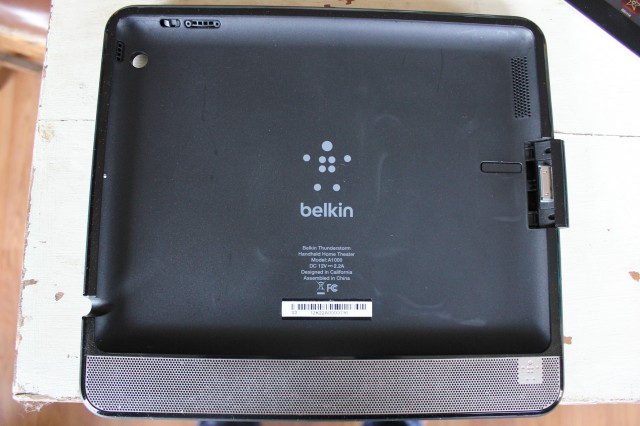
Powering all that sound equipment is a battery, which Belkin says should last 10 hours. We ran hours of Netflix movies (placing the iPad and Thunderstorm in a separate room) and found that after 7 hours, the case and the iPad were still going strong at maximum volume. As an added bonus, when you have the Thunderstorm case plugged in, it also charges your iPad.
The first thing I noticed when using Belkin's case was how well-balanced the bass was. While any upgrade from the iPad's original speakers is an improvement, the Thunderstorm really does impress when you're using it in an enclosed space, and especially when you're interacting with the iPad at arm's length.
Higher frequency pitches also came in clear. Only once did I notice any harsh high-pitched hissing on a sibilant consonant—in the introduction to the first episode of the Discovery Channel's Submarine: Hidden Hunter—and I was unable to recreate the effect elsewhere, so it may have been the audio quality of the show I was watching.
One interesting addition that Belkin threw into the Thunderstorm was an accompanying app that lets you set the audio distance between the two speakers. Its three settings—normal, wide, and super wide—are intended to offer clean sound quality no matter your distance to the speakers. At the "normal" setting, mid-range tones sounded like they were coming through a tunnel if I was anywhere closer than 18 inches from the case. When I set the audio to “super wide” I was able to eliminate that effect and hold the iPad close to me as I watched It's Always Sunny in Philadelphia. If I strayed too far from the iPad at that setting though, high notes started sounding a bit thin. But again, this was rectified by setting the Thunderstorm app back to “Normal” (Or “wide” when I was sitting at my desk with the iPad perched about 2.5 feet away on my printer).
Watching the four episodes of Submarine: Hidden Hunter, I found that the Thunderstorm had no problem filling a bedroom with sound at full-blast, even masking the loud rumble of the space heater I had on under the desk. Usually, at night and without a space heater on, setting the volume about midway was more than sufficient to deliver good, room-filling sound. (A slight perfectionist's quibble about iOS: touching the volume rocker brings up the iPad's native volume overlay. But clicking the rocker to the right decreases the volume, sending the squares on the volume icon to the left (and vice versa), creating this weird cognitive dissonance moment).

The Thunderstorm is also well-suited to game-playing. I played a bit of The Room and Machinarium, and the 2.1 audio made the wispy bells and minor notes of both games' background music seem like they were everywhere. Without waxing too poetic, I felt transported into the game.
In the case of loud sounds, there's even a bit of tactile feedback on explosions and such, but we were told that there were no excitors or anything of that nature in the Thunderstorm.
Should you buy one now?
This question is best answered depending on how you use your iPad. My boyfriend drives to work and I work from home, so we don't frequently use it on public transit or while waiting for the train (with it weighing down on our shoulders). I used the case as a sort of secondary home theater system, setting it up on our bedside table so we could watch movies without the inconvenience of relocating before passing out for the night.
The Thunderstorm seems suited for something analogous to that use case. But if your iPad use is largely stationary, wouldn't it be more cost-effective to get a speaker dock? Possibly, although some of the highest rated bluetooth-pairing-enabled speakers (like this Jawbone Jambox) seemed made for filling a room with music, rather than more directional watching-movies-and-playing-games. The highest-rated 30-pin iPad docks (like JBL's OnBeat Xtreme) are often more than $200. Clearly, there are individual speakers you can buy if you just want to watch Hulu on your iPad (like the Hidden Radio speaker we reviewed last year), but after looking around a bit at other high-end products, Belkin's Thunderstorm suddenly seems like it's not such a gouging.

The Thunderstorm has a minimal amount of moving and separate parts, and it offers very good audio. I found a few other iPad speaker-cases that are cheaper (most of which really look cheaper), as well as the remnants of a recently defunct (yet fully funded) Kickstarter project called the ORA 8-speaker iPad case, which would have looked quite similar to this case (but you could have had an ORA for $100... in an alternative future where the project actually went as planned).
All in all, if you move your iPad occasionally—that is, it doesn't always stay in one place but you're not commuting with it daily—this is just the case for you. You can still plug in your headphones when you're on the go, but you don't have to carry along an extra dock or speaker if you want to use your iPad to watch movies and play games in multiple rooms of your house or in a hotel room. This could similarly work for the strong-of-stomach riding in the back of your car on a road trip, or for the bodybuilders who want to blast their iTunes library from their shoulders as they rollerblade along the beach.
The Good
- Excellent, room filling sound
- No tinny highs or too-deep bass
- Sturdy case
- Accompanying app lets you adjust sound to maximize the system's “sweet spot”
The Bad
- A bit expensive for an older-model-iPad case (though Belkin says it will have a new version for the latest iPad model sometime in May or June of this year).
- It's heavy
The Ugly
- The case cover is weak
No comments:
Post a Comment
Let us know your Thoughts and ideas!
Your comment will be deleted if you
Spam , Adv. Or use of bad language!
Try not to! And thank for visiting and for the comment
Keep visiting and spread and share our post !!
Sharing is a kind way of caring!! Thanks again!